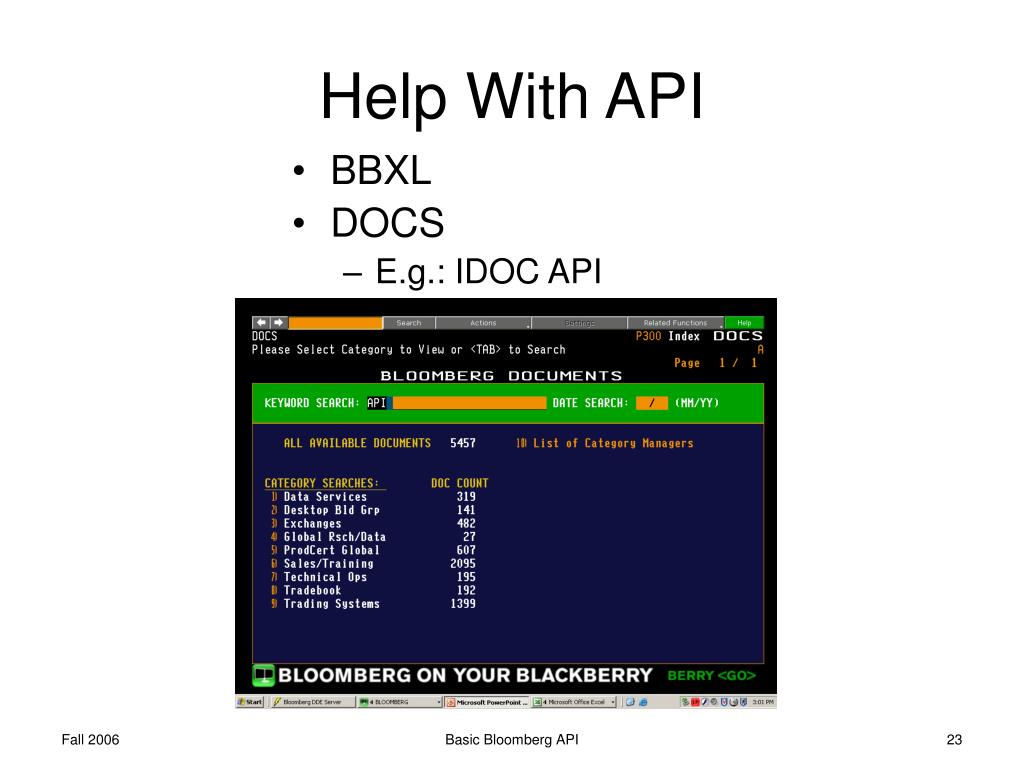
Must be called to read incoming events and Or subsequently added with using SetEventHandler(EventHandler, Event EventType).Ī session is synchronous if an EventHandler is not supplied All incomingĮvents are delivered to the event handler(s) supplied on construction May be used to adjust the way events are handled subsequently and SetEventHandler(EventHandler, Event EventType)

Is determined when it is constructed and cannot be changed subsequently.Ī session is asynchronous if an EventHandler is supplied A Session can dispatch events and replies in either a Sessions manage access to services either by requests and responses or Programmatically, the customer application obtains Event objects for the Session and then extracts from those Event objects one or more Message objects containing the Bloomberg data.Ī session for making requests and subscriptions to services. Whichever paradigm or paradigms are used, the Bloomberg infrastructure replies with events (received at the client as Event objects) which the client Depending on the services being used, a customer application may be written to Subscription (managed via a Subscription object) with the service for ongoing data updates.


The client can make individual requests (via a Request object) for data or the client can start a There are two programming paradigms that can be used with the Service object. For example, Bloomberg provides streaming market data and reference data as services. Using the Session object, an application creates a Service object and then "opens' each Bloomberg service that it will use. (Some applications may choose to create multiple Session objects for The Bloomberg API object model contains a small number of key objects which applications use to request, receive and interpret data.Īn application creates a Session object to manage its connection with the Bloomberg infrastructure. It also makes writing applications that can adapt to changes in services or entirely new services simple. This means the Bloomberg API can support additional services without additions to the interface. The Bloomberg API supports run-time downloadable schemas for the services it provides and provides methods to query these schemas at runtime. You can choose which data you require down to the individual field level. The Bloomberg API lets you integrate streaming real-time and delayed data, reference data, historical data, intraday data, and Bloomberg derived data into custom and thirdparty applications. Plus, permissioning is simple with the Bloomberg toolkit so customers can control the distribution of data within the organization.The Bloomberg API provides developers with 24x7 programmatic access to data from the Bloomberg Data Center for use in customer applications. SAPI takes into account your existing Bloomberg Terminal exchange entitlements. With SAPI, clients can leverage the data users already have access to in the Bloomberg Terminal, eliminating the need for separate data licensing agreements. In that time we’ve built the infrastructure and developed the knowledge base needed to translate global market activity into world class market data,” said Jeffrey Buhrman, Real-time Technology Sales Specialist at Bloomberg. “Bloomberg has been around for more than 40 years. Relying on data from multiple sources can lead to inconsistencies in the way data is invested and cleaned.

Other data providers may be strong in specific markets or regions, but users may still need to rely on another source for data outside of that specialty area. Breadth and depth of Bloomberg dataīloomberg is the benchmark for international markets across all asset classes when it comes to data. With SAPI, users have a unified view of global markets whether they are managing orders, measuring risk or analyzing portfolios - on or off the Bloomberg Terminal. Longer reconciliations means more money lost as a result of not being able to settle a trade,” said Stephanie Davis, Real-time Product Specialist and Presales Engineer at Bloomberg. “The last thing you want to have happen is to see a different number in the order management system. This helps reduce inconsistencies that can complicate workflow. With SAPI, the data feeding into the application is the same as data found in the Bloomberg Terminal. When firms feed an application with a different data source, discrepancies can occur.


 0 kommentar(er)
0 kommentar(er)
